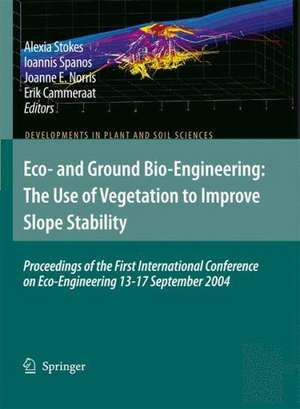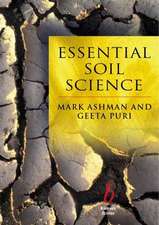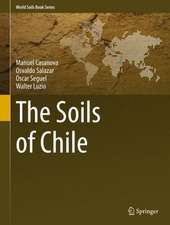Eco- and Ground Bio-Engineering: The Use of Vegetation to Improve Slope Stability: Proceedings of the First International Conference on Eco-Engineering 13-17 September 2004: Developments in Plant and Soil Sciences, cartea 103
Editat de A. Stokes, Ioannis Spanos, Joanne E. Norris, Erik Cammeraaten Limba Engleză Paperback – 19 noi 2010
| Toate formatele și edițiile | Preț | Express |
|---|---|---|
| Paperback (1) | 965.02 lei 6-8 săpt. | |
| SPRINGER NETHERLANDS – 19 noi 2010 | 965.02 lei 6-8 săpt. | |
| Hardback (1) | 970.70 lei 6-8 săpt. | |
| SPRINGER NETHERLANDS – 5 mar 2007 | 970.70 lei 6-8 săpt. |
Din seria Developments in Plant and Soil Sciences
- 18%
 Preț: 1225.94 lei
Preț: 1225.94 lei -
 Preț: 391.79 lei
Preț: 391.79 lei - 18%
 Preț: 1225.94 lei
Preț: 1225.94 lei - 18%
 Preț: 1228.29 lei
Preț: 1228.29 lei - 18%
 Preț: 1246.95 lei
Preț: 1246.95 lei - 24%
 Preț: 1073.18 lei
Preț: 1073.18 lei - 18%
 Preț: 970.70 lei
Preț: 970.70 lei - 24%
 Preț: 1073.76 lei
Preț: 1073.76 lei -
 Preț: 396.24 lei
Preț: 396.24 lei -
 Preț: 386.81 lei
Preț: 386.81 lei - 15%
 Preț: 699.93 lei
Preț: 699.93 lei -
 Preț: 384.86 lei
Preț: 384.86 lei - 18%
 Preț: 1221.69 lei
Preț: 1221.69 lei - 18%
 Preț: 1233.06 lei
Preț: 1233.06 lei -
 Preț: 399.12 lei
Preț: 399.12 lei - 18%
 Preț: 1227.67 lei
Preț: 1227.67 lei -
 Preț: 383.93 lei
Preț: 383.93 lei - 18%
 Preț: 1826.85 lei
Preț: 1826.85 lei - 18%
 Preț: 1232.09 lei
Preț: 1232.09 lei - 15%
 Preț: 646.94 lei
Preț: 646.94 lei - 18%
 Preț: 1231.47 lei
Preț: 1231.47 lei - 15%
 Preț: 650.55 lei
Preț: 650.55 lei - 15%
 Preț: 638.24 lei
Preț: 638.24 lei - 18%
 Preț: 955.08 lei
Preț: 955.08 lei -
 Preț: 385.61 lei
Preț: 385.61 lei -
 Preț: 382.36 lei
Preț: 382.36 lei -
 Preț: 407.98 lei
Preț: 407.98 lei -
 Preț: 393.35 lei
Preț: 393.35 lei - 18%
 Preț: 1224.54 lei
Preț: 1224.54 lei - 18%
 Preț: 1222.01 lei
Preț: 1222.01 lei - 18%
 Preț: 1228.15 lei
Preț: 1228.15 lei -
 Preț: 382.95 lei
Preț: 382.95 lei - 18%
 Preț: 1227.84 lei
Preț: 1227.84 lei
Preț: 965.02 lei
Preț vechi: 1176.86 lei
-18% Nou
Puncte Express: 1448
Preț estimativ în valută:
184.65€ • 193.31$ • 152.79£
184.65€ • 193.31$ • 152.79£
Carte tipărită la comandă
Livrare economică 05-19 aprilie
Preluare comenzi: 021 569.72.76
Specificații
ISBN-13: 9789048174034
ISBN-10: 9048174031
Pagini: 452
Ilustrații: IX, 411 p.
Dimensiuni: 193 x 260 x 24 mm
Greutate: 1.01 kg
Ediția:Softcover reprint of hardcover 1st ed. 2007
Editura: SPRINGER NETHERLANDS
Colecția Springer
Seria Developments in Plant and Soil Sciences
Locul publicării:Dordrecht, Netherlands
ISBN-10: 9048174031
Pagini: 452
Ilustrații: IX, 411 p.
Dimensiuni: 193 x 260 x 24 mm
Greutate: 1.01 kg
Ediția:Softcover reprint of hardcover 1st ed. 2007
Editura: SPRINGER NETHERLANDS
Colecția Springer
Seria Developments in Plant and Soil Sciences
Locul publicării:Dordrecht, Netherlands
Public țintă
ResearchCuprins
Mechanisms and modelling of root reinforcement on slopes.- The influence of cellulose content on tensile strength in tree roots.- Novel biomechanical analysis of plant roots.- Root reinforcement: analyses and experiments.- Root strength and root area ratio of forest species in Lombardy (Northern Italy).- Biotechnical characteristics of root systems of typical Mediterranean species.- Uprooting resistance of vetiver grass (Vetiveria zizanioides).- Root reinforcement by hawthorn and oak roots on a highway cut-slope in Southern England.- Protection roles of forest and non-forest woody species on slopes in Iran.- Reinforcement of tree roots in slope stability: A case study from the Ozawa slope in Iwate Prefecture, Japan.- Observation and simulation of root reinforcement on abandoned Mediterranean slopes.- Slope stabilisation by perennial ‘gramineae’ in Southern Italy: plant growth and temporal performance.- Root system morphology and anchorage.- Root system asymmetry of Mediterranean pines.- Root morphology, stem growth and field performance of seedlings of two Mediterranean evergreen oak species raised in different container types.- Stabilising characteristics of New Zealand indigenousriparian colonising plants.- Mechanical resistance of different tree species to rockfall in the French Alps.- Root morphology and strain distribution during tree failure on mountain slopes.- A numerical investigation into the influence of soil type and root architecture on tree anchorage.- Methodology applied to eco- and ground bio-engineering.- SLIP4EX – A program for routine slope stability analysis to include the effects of vegetation, reinforcement and hydrological changes.- Site investigation for the effects of vegetation on ground stability.- Mechanics of root-pullout from soil: A novel image and stress analysis procedure.- Dendrogeomorphological observations in a landslide on Tymfristos mountain in Central Greece.- Monitoring ground bio-engineering stabilization of landslides in Lazio Region, Italy.- The use of geostatistical techniques applied to soil conservation of low-density woodlands.- A computer system using two membership functions and T-Norms for the calculation of mountainous watersheds torrential risk: The case of lakes Trixonida and Lisimaxia.- Comparison between two low cost photogrammetric systems: The analytical instrument Adam ASP2000 and the digital photogrammetric station DVP.- Applications at the slope level.- Vegetative-based technologies for erosion control.- Vegetation succession and its consequences for slope stability in SE Spain.- Hedge brush layers and live crib walls—stand development and benefits.- Vegetation dynamics on sediment deposits upstream of bioengineering works in mountainous marly gullies in a Mediterranean climate (Southern Alps, France).- Implementation and monitoring of soil bioengineering measures at a landslide in the Middle Mountains of Nepal.- Beech coppice short-term hydrological balance for simulated rainfall.- Beech coppice leaf cover and gross rainfall quali–quantitative transformation in simulated rainfall events of high intensity.- Effect of repeated fire on plant community recovery in Penteli, central Greece.- Effects of postfire logging on soil and vegetation recovery in a Pinus halepensis Mill. forest of Greece.- The contribution of agrotechnical works following a fire to the protection of forest soils and the regeneration of natural forest.- Decision support systems in eco-engineering: the case of the SDSS.- A decision support system for the evaluation of eco-engineering strategies for slope protection.- Eco- and ground bio-engineering case studies by practitioners.- Land restoration for the Olympic Games in Athens, Greece: Case study Lycabettus slopes (cycle road).- Herbaceous plant cover establishment on highway road sides.- Erosion control by application of hydroseeding methods along the Egnatia Motorway (Greece).- Restoration of slopes disturbed by a motorway company: Egnatia Odos, Greece.- Instability effects of the landforms, in artificially modulated banks along the road Thermopylae–Nafpactos (Ftiotida, Greece).- Evaluation of revegetation techniques on mining spoil slopes.- Revegetation on steep slopes and in subalpine areas using biennial cover plants: A review of Huter’s technique.- Comparison of revegetation techniques on alpine slopes prone to avalanches and erosion.
Textul de pe ultima copertă
In an era where climate change, natural catastrophes and land degradation are major issues, the conservation of soil and vegetation in mountainous or sloping regions has become an international priority. How to avoid substrate mass movement through landslides and erosion using sustainable and ecologically sound techniques is rapidly becoming a scientific domain where knowledge from many different fields is required. These proceedings bring together papers from geotechnical and civil engineers, biologists, ecologists and foresters, who discuss current problems in slope stability research, and how to address those problems using ground bio- and eco-engineering techniques.
Ground bioengineering methods integrate civil engineering techniques with natural materials to obtain fast, effective and economic methods of protecting, restoring and maintaining the environment whereas eco-engineering has been defined as a long-term ecological strategy to manage a site with regard to natural or man-made hazards. Studies on slope instability, erosion, soil hydrology, mountain ecology, land use and restoration and how to mitigate these problems using vegetation are presented by both scientists and practitioners. Papers encompass many aspects of this multidisciplinary subject, including the mechanisms and modelling of root reinforcement and the development of decision support systems, areas where significant advances have been made in recent years.
Ground bioengineering methods integrate civil engineering techniques with natural materials to obtain fast, effective and economic methods of protecting, restoring and maintaining the environment whereas eco-engineering has been defined as a long-term ecological strategy to manage a site with regard to natural or man-made hazards. Studies on slope instability, erosion, soil hydrology, mountain ecology, land use and restoration and how to mitigate these problems using vegetation are presented by both scientists and practitioners. Papers encompass many aspects of this multidisciplinary subject, including the mechanisms and modelling of root reinforcement and the development of decision support systems, areas where significant advances have been made in recent years.
Caracteristici
New scientific research and practical advice in the field of ground bio- and eco-engineering Recent studies on slope stabilisation and erosion control techniques presented and discussed by world renowned experts Interaction between substrate movement and vegetation discussed by geotechnical engineers, hydrologists and plant biologists State-of-the-art technical and modelling methods presented by engineers, biologists and foresters









